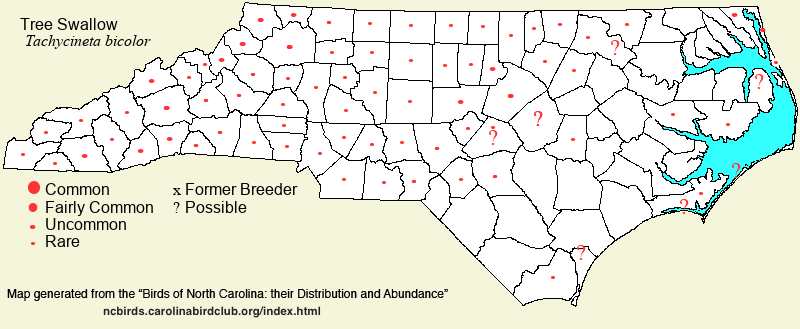 |  |
|
Tree Swallow - Tachycineta bicolor HIRUNDINIDAE Members: | Search Common: Search Scientific: |
|
|
|||||||
| General Comments | The Tree Swallow is by far the most cold-hardy swallow in North America, being the only one to winter in substantial numbers in the southern part of the country. Fortunately, the species switches much of its diet to feeding on berries, particularly Waxmyrtle berries, though the birds certainly feed on flying insects during mild winter spells. The species nests over much of the continent, and its breeding range has expanded southward in recent decades, to include North Carolina. Currently, it nests in the mountains, and sparingly in the Piedmont and Coastal Plain. It nests singly in cavities, such as in bluebird boxes or holes in dead trees at lakes; fresh water ponds or lakes are essential in a territory. In winter, birds occur along and near the coast, and they winter near open water areas where there are stands of Waxmyrtle (or Red Cedar) nearby. At the latter season, the birds can occur in large flocks, of up to several thousand birds, and thus can be locally absent. | ||||||
| Breeding Status | Breeder | ||||||
| NC BRC List | Definitive | ||||||
| State Status | |||||||
| U.S. Status | |||||||
| State Rank | S3B,S4N | ||||||
| Global Rank | G5 | ||||||
| Coastal Plain | Breeder and winter resident, with noticeable migratory movements; scarce but increasing as a breeder. Breeds mostly at a few sites near the coast, including in Tidewater; nested for the first time in the Sandhills in 2015. The most consistent site appears to be Mackay Island NWR (Currituck). Has nested far inland in Halifax in 2011-2013. Nesting has also occurred in Dare, Mattamuskeet NWR, Beaufort [county], Eagle Island (Brunswick), and at McKinney Fish Hatchery (Richmond). The N.C. Bird Atlas shows confirmed nesting south to Carteret, Wayne, Cumberland, and Hoke. In winter, uncommon to locally abundant (such as at Lake Mattamuskeet) in Tidewater and along the coast; sporadic in occurrence, and can be absent in suitable habitat for weeks at a time. Common to at times abundant in migration in these same areas. Farther inland, mostly uncommon to briefly and locally common transient; rare visitor in winter. Inland, mainly mid-Mar to mid-May, and late Jul into Oct. Peak counts: 100,000, Eagle Island near Wilmington, 6 Nov 1987. | ||||||
| Piedmont | Transient, and sparse breeder, slightly increasing as a breeder. In summer, rare to locally fairly common, mostly at reservoirs (nests in dead trees in standing water, such as at Jordan and Falls lakes), but now using bird boxes over much of the province; absent in some or many counties, and can be sporadic from year to year. Uncommon to often common transient in spring; generally uncommon in fall; most numerous around larger reservoirs. Mostly mid-Mar to mid-May, and late Jul into Oct. Peak counts: 2,000, Salem Lake (Forsyth), 6 Apr 1996. | ||||||
| Mountains | Summer resident, with migratory movements; increasing as a breeder. Uncommon to fairly common breeder at low elevations, especially in broad valleys near water; uncommon at middle elevations, up to perhaps 4,000 feet; rare to absent above that elevation in summer. Can be a fairly common migrant, at least in spring; mainly late Mar to late May, and mid-Aug into Oct. Peak counts: an estimated 29,000, Ecusta Pond (Transylvania), 11 Oct 2022; 4,200, Ecusta Pond, 20 Sep 2017; 300+, Hooper Lane (Henderson), 13 Jul 2014. | ||||||
| Finding Tips |
The species is most easily seen at large lakes toward the coast in the cooler months. Though never a 100% surety, you should be able to find birds in late fall and winter around Lake Mattamuskeet or the nearby impoundments. *** to **** | ||||||
| Attribution | LeGrand[2024-11-06], LeGrand[2023-03-26], LeGrand[2023-03-20] | ||||||
| NC Map Map depicts all counties with a report (transient or resident) for the species. | Click on county for list of all known species. |
| NC Breeding Season Map Map depicts assumed breeding season abundance for the species. |  |